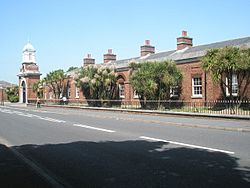Forton Barracks facts for kids
Quick facts for kids Forton Barracks
|
|
|---|---|
| Gosport, Hampshire | |

Forton Barracks
|
|
|
Location within Hampshire
|
|
| Coordinates | 50°48′00″N 1°08′10″W / 50.800°N 1.136°W |
| Type | Royal Marines Base |
| Site history | |
| Built | 1807 |
| Built for | Admiralty |
| In use | 1807-1923 |
| Garrison information | |
| Occupants | Portsmouth Division, Royal Marines |
Forton Barracks was a military base located near Gosport in Hampshire, England. It started as a place for the British Army. Later, it became a main base for the Royal Marines. After that, it was used by the Royal Navy to train young sailors. Today, the land where Forton Barracks once stood is home to St Vincent College.
Contents
History of Forton Barracks
Building the Barracks
In the late 1700s, the owner of Forton Mill sold some land. This land was bought by the Board of Ordnance. They planned to build a hospital for the Army there. This hospital, called Forton Military Hospital, began construction in 1797.
However, by 1800, soldiers were already getting treatment at the nearby Naval hospital in Haslar. So, the plan changed. The buildings meant for the hospital were turned into a barracks instead.
Opening and Early Use
Forton Barracks officially opened in 1807. It had four tall buildings connected by covered walkways. This design was similar to other military hospitals built around that time. These buildings faced a large open area called a parade ground. This parade ground was thought to be one of the biggest in the country.
For the next 40 years, different Army groups stayed at the barracks. The buildings could hold 832 soldiers and 48 sergeants. But by the 1840s, one building was still a hospital. Another had its ground floor changed into the officers' mess, which was a dining and social area for officers. Other spaces were used for classrooms, workshops, and storage.
Royal Marines Move In

At this time, the Royal Marines' Portsmouth Division was in Old Portsmouth. They were in buildings that used to be a brewery. These buildings, called Clarence Barracks, were becoming too small for them.
So, a deal was made. The Board of Ordnance traded Forton Barracks for Clarence Barracks. Clarence Barracks was then used by the Royal Artillery. This allowed the Royal Marines to move into Forton.
Expanding the Base
To fit a whole Royal Marine division, Forton Barracks needed to get bigger. Captain Henry James of the Royal Engineers led this project. They added a large officers' mess on the east side of the parade ground. This mess had space for 80 diners and a 30-piece orchestra upstairs. It also had a library and breakfast room downstairs.
Captain James also built two long, single-story buildings. These were used as a school and offices. He also made the main gate bigger by adding a clock tower. More buildings were added behind the main barracks for storage and other needs.
Life as a Royal Marine Base
The Royal Marines officially took over the barracks in 1848. Soon after, they were renamed the Royal Marine Light Infantry. This was to tell them apart from the Royal Marine Artillery. The Artillery had their own barracks near the Gunwharf Quays.
In 1858, the nearby mill and its pond were bought by the Admiralty. The pond was drained and became part of the barracks site. By 1862, more barracks buildings were built between the old pavilions. This allowed the base to hold over 1000 men. More expansion happened in the 1890s, with homes built for married officers. A theatre with 400 seats was also built on the site in 1893.
Changing Hands Again
In 1922, there were cuts to defense spending. This meant the Portsmouth Division of the Royal Marine Light Infantry and the Royal Marine Artillery joined together. The new Royal Marines Portsmouth Division moved to Eastney Barracks in August 1923. This left Forton Barracks empty.
In 1927, the barracks was given a new purpose. It became HMS St. Vincent. This was a Royal Naval training center for young boy seamen and juniors. It continued to be a Royal Navy base until 1969.
Cadets at Forton Barracks
In 1904, a group called the Royal Marines Light Infantry Cadet Corps was started. This group was similar to the successful Royal Marines Artillery Cadet Corps at Eastney Barracks. It was part of the Royal Navy's Volunteer Cadet Corps. The Forton Division RMLI Cadet Corps closed some years later. However, today's Gosport Division Royal Marines Volunteer Cadet Corps continues its traditions. They are now based at HMS Sultan.
Gallery








